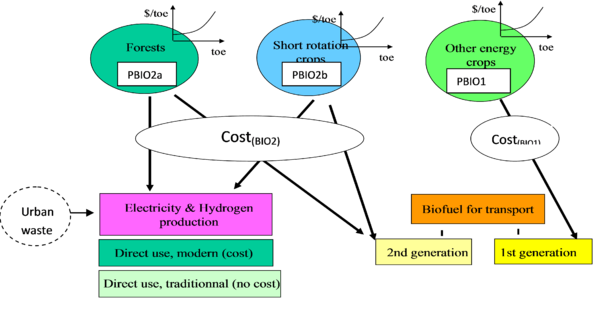Bioenergy - POLES
| Corresponding documentation | |
|---|---|
| Previous versions | |
| Model information | |
| Model link | |
| Institution | JRC - Joint Research Centre - European Commission (EC-JRC), Belgium, http://ec.europa.eu/jrc/en/. |
| Solution concept | Partial equilibrium (price elastic demand) |
| Solution method | SimulationRecursive simulation |
| Anticipation | Myopic |
Primary biomass resources for energy uses are classified in 3 categories for all countries/regions:
- energy crops (in agricultural area, grassland)
- short rotation crops (cellulosic)
- forest residues (cellulosic)
Energy crops are dedicated to 1st generation biofuels, the 2 other categories are used in all other energy uses (a further split of biomass feedstocks has been implemented for Europe using information from the model GREEN-X). POLES uses by default a simplified modeling of land use to estimate the potential of these resources: land available, yields (evolve over time, based on historical evolution), share of harvest/land that can be allocated to energy uses.
<figure id="fig:POLES_7">
</figure>
POLES also uses in a standard way exogenous estimates of potentials: for instance a soft linkage with the model GLOBIOM/G4M has been implemented that goves potential estimates and cost curves for all World regions (with the model GREEN-X at EU level). Biomass supply cost curves are attached to the various biomass types and come from GREEN-X, GLOBIOM and other sources.
The conversion into liquid biofuels distinguishes first generation (agricultural energy crops) and second generation (cellulosic).
The model has been used in several studies to examine the future use of biomass as an energy sourcemubareka2014an, bio-energy tradematzenberger2015fukranzl2013me and the role of biomass in emissions mitigationluderer2013thvuuren2010bi.
Information sources include: FAOFAO 2015.
